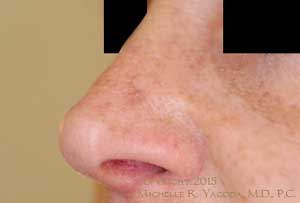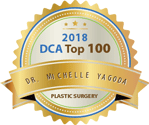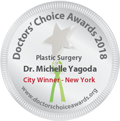
Aside from melanomas, most skin cancers are relatively easy to treat. While they present hurdles in the pathway of life, and leave permanent signs of their journey, they generally do not derail life’s course. Cancers of the skin of the nose pose some unique challenges. First, there is not much real estate to spare since each centimeter of skin has an important functional role! In addition, multiple adjacent facial subunits (i.e., the cheek, the upper lip, the upper eyelid, etc.), created by deep fusion planes, enable cancers on the nose to quietly travel deeply along the fusion planes and cause more damage.
Mohs micrographic surgery (MMS/MOHS) is a skin-sparing surgical technique used to remove cancerous lesions. As a facial plastic surgeon, Dr. Yagoda works with the dermatologist specializing in MOHS surgery to ensure complete cancer removal and an inconspicuous closure to produce the desired cosmetic result. During the surgery, thin sections of the skin surrounding the lesion are removed and immediately examined under a microscope in a lab at the same location. (In typical excisional biopsies, the skin is sent to a lab off-premises and results are not available for several days). If evidence of cancer is found, another thin section is removed until the margins of the area are found to be free of suspicious cells. MOHS technique ensures the complete removal of all microscopically diseased tissue while preserving the maximum amount of healthy surrounding tissue.
Although MOHS surgery is time-consuming, it has the lowest recurrence rate of malignancies and preserves more healthy tissue than other methods. It’s the treatment of choice for aggressive or recurrent carcinomas and especially for lesions in particular areas of the face.
Even though MOHS is as skin sparing as possible and many procedures result in tiny, completely inconspicuous scars, some lesions are simply too big, too deep, or too conspicuously placed to be removed without leaving a noticeable or even disfiguring scar. In these instances, a facial plastic surgeon, like Dr. Michelle Yagoda of New York City, can reconstruct the nose area via a functional and cosmetic rhinoplasty surgery to restore her patient’s appearance. View actual results here.
Contact our office in New York City (NYC)/ Manhattan to schedule your facial plastic surgery consultation. Ideally, you should see Dr. Yagoda in advance of the MOHS surgery, so that she can plan for a repair and coordinate her schedule with that of your MOHS surgeon.
The Procedure
Reconstructive rhinoplasty surgery (nose repair) after MOHs resection can be performed in Dr. Yagoda’s New York City/Manhattan office-based surgical facility or in a NYC hospital, under local anesthetic, local anesthetic with IV sedation or under general anesthesia. This plastic surgery procedure takes between 45 minutes and two hours. The exact surgical technique is uniquely tailored by the plastic surgeon for each patient, but most of the time incisions are hidden along natural skin tension lines and within sub-units of the nose and face. View actual photos here.
Recovery
You can return to work the next day after your reconstructive plastic surgery and you’ll be able to use a stationary bike or treadmill by the second week. By the third week, you can return to full activities. Although you’ll see immediate improvement, your nose’s shape and your profile will continue to refine over the next 12 to 18 months.
Risks
Like all surgery, reconstructive nasal surgery has certain risks including infection, bleeding, and reaction to anesthesia. Other risks include structural damage to the nose. Dr. Yagoda will discuss these potential risks as well as the benefits of this plastic surgery procedure in full during your consultation in her New York City/NYC/Manhattan office.
Read about Dr. Yagoda’s Reconstructive Rhinoplasty Surgery Integrative Post Operative Care Program
Flying In
Dr. Yagoda’s patients come to New York, NYC, and Manhattan from all over the world. From Qatar to Quebec, we can help you get here from abroad.


































